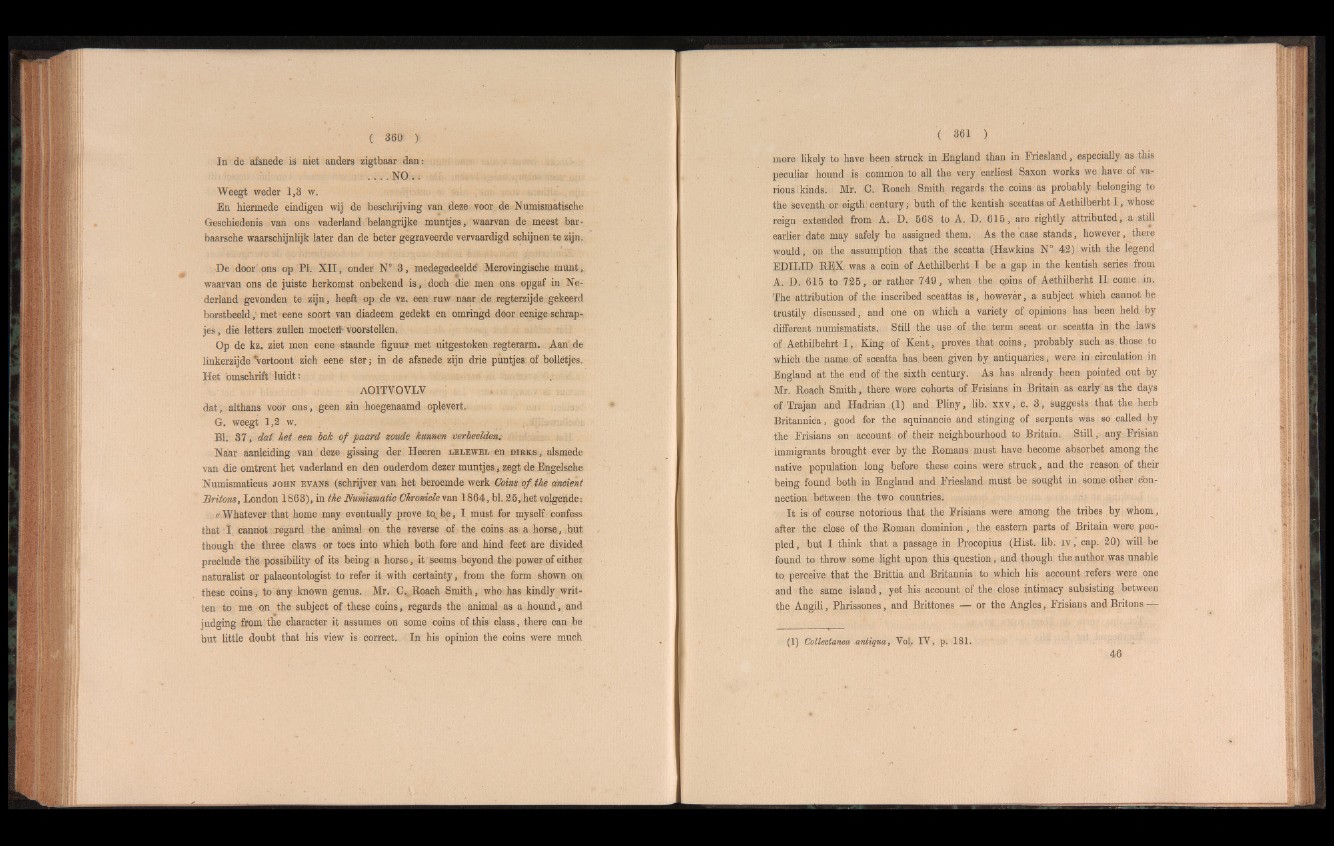
In de afsnede is niet anders zigtbaar dan:
NO..
Weegt weder 1,3 w.
En hiermede eindigen wij de beschrijving van deze voor de Numismatische
Geschiedenis van ons vaderland belangrijke muntjes, waarvan de meest bar-
baarsehe waarschijnlijk later dan de beter gegraveerde vervaardigd schijnen te zijn.
-De door ons op PI. XII, onder N° 3, medegedeelde Merovingische munt,
waarvan ons de juiste herkomst onbekend is, doch die men ons opgaf in Nederland
gevonden te zijn, hepft op de vz. een ruw naar de regterzijde gekeerd
borstbeeld, met eene soort van diadeem gedekt en omringd door eenige schrap-
jes, die letters zullen moetert- voorsteilen.
Op de kz. ziet men eene staande figuur met uitgestoken regterarm. Aan de
linkerzijde ‘vertoont zieh eene ster; in de afsnede zijn drie puntjes of bolletjes.
Het omschrifl luidt: ,
AOITVOVLV
dat, althans voor ons, geen zin hoegenaamd oplevert.
G. weegt 1,2 w.
Bl. 37', dat het een bok of paard zoude kunnen verbeelden.
Näar aanleiding van deze gissing der Heeren lelewel en dirks , alsmede
van die omtrent het vaderland en den ouderdom dezer muntjes, zegt de Engelsche
Numismaticus john evans (schrijver van het beroemde werk Coins of the ancient
.Britons, London 1863), in the Numismatic Chronicle van 1864, bl. 25, het volgende:
n Whatever that home may eventually prove to_ be, I must for myself confess
that I cannot regard the animal on the reverse of the coins as a horse, but
though the three claws or toes into which both fore and hind feet are divided
preclude the possibility of its being a horse, it seems beyond the power of either
naturalist or palaeontologist to refer it with certainty, from the form shown on
these coins, to any known genus. Mr. C.(l Roach Smith, who has kindly written
to me on the subject of these coins, regards the animal as a hound, and
judging from the character it assumes on some coins of this class, there can be
but little doubt that his view is correct. In his opinion the coins were much
more likely to have been struck in England than in Friesland, especially as this
peculiar hound is common to all the very earliest Saxon works we have of various
kinds. Mr. C. Roach Smith regards the coins as probably belonging to
the seventh or eigth century; biith of the kentish sceattas of Aethilberht I , whose
reign extended from A. D. 568 to A. D. 615, are rightly attributed, a still
earlier date may safely be assigned them. As the case stands, however, there
would, on the assumption that the sceatta (Hawkins N° 42) with the legend
EDILID REX was a coin of Aethilberht I be a gap in the kentish series from
A. D. 615 to 725, or rather 749, when the (¡pins of Aethilberht II come in.
The attribution of the inscribed sceattas is, however, a subject which cannot be
trustily discussed, and one on which a variety of opinions has been held by
different numismatists. Still the use of the term seeat or sceatta in the laws
of Aethilbehrt I , King of Kent, proves that coins, probably such as those to
which the name of sceatta has. been given by antiquaries, were in circulation in
England at the end of the sixth century. As has already been pointed out by
Mr. Roach Smith, there were cohorts of Frisians in Britain as early as the days
of Trajan and Hadrian (1) and Pliny, lib. xxv, c. 3, suggests that the herb
Britannica, good for the squinancie and stinging of serpents was so called by
the Frisians on account of their neighbourhood to Britain. Still, any Frisian
immigrants brought ever by the Romans must have become absorbet among the
native population long before these coins were struck, and the reason of their
being found both in England and Friesland must be sought in some other connection
between the two countries.
It is of course notorious that the Frisians were among the tribes by whom,
after the close of the Roman dominion, the eastern parts of Britain were peopled,
but I think that a passage in Procopius (Hist. lib. iv, cap. 20) will be
found to throw some light upon this question , and though the author was unable
to perceive that the Brittia and Britannia to which his account refers were one
and the same island, yet his account of the close intimacy subsisting between
the Angili, Phrissones, and Brittones — or the Angles, Frisians and Britons —
(1) Collectanea antique, Vol. IV , p. 181.